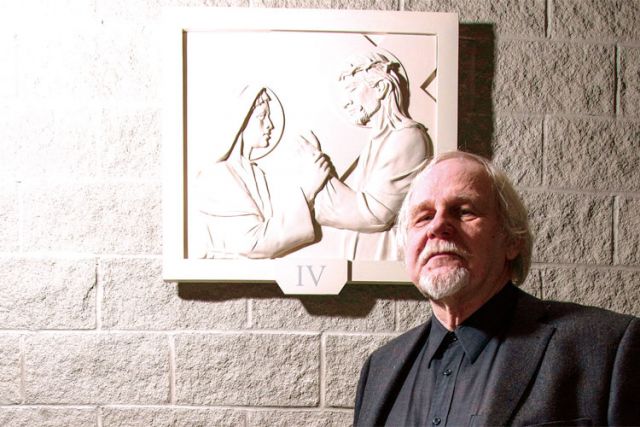“So they had stumps for hands and feet and they dragged themselves into church,” recalled Tobin.
In those days the young priest smoked and would wander down into the village to have his cigarette in the evening and sit among the lepers. From the legless and outcast, Tobin learned less about suffering than he did about living.
“I would sit there. I often said I found more contentment there than I’ve found any place else,” he said. “People kind of came to terms with it.”
After Nigeria, the Irish priest embarked on a new life in the Toronto suburb of Brampton — a priest among the angst-ridden teenagers of a bedroom community’s growing high schools. His long service as chaplain to the kids and families of Brampton resulted in a street named Fr. Tobin Road in Bramalea.
For the 50th anniversary of Tobin’s ordination the big, young parish of St. Marguerite d’Youville asked their retired (but not really retired) priest what he would like. He wanted to see the stations of the cross arrayed around the sanctuary of the church.
The parish already had a remarkable set of stations of the cross made from iron in the welding shop of the Ontario Correctional Institute. But those stations seemed small in the big, bright church. They didn’t quite fit. The stations Tobin wanted would be a continuation of the two-and-a-half metre tall corpus that hung on a giant cross behind the altar.
The parish went to the sculptor who made the crucifix that dominates their Sunday Masses and commissioned a traditional 14 stations of the cross. Gregory Furmanczyk was only too happy to return more than 15 years later to the vision which inspired that corpus.
“I felt very inspired,” said the artist. “I felt like I was coming home to a place that I had been before. I knew right from the beginning that these stations had to be created to complete the whole artistic thought.”
The completion of that thought was blessed and prayed over the first Monday of Lent, April 3. The parish returned the old stations of the cross to the Ontario Correctional Institute’s gallery of prisoner art and prayed through the new stations.
The new stations are unique and modern, but at the same time traditional.
“We didn’t want to go with cookie-cutter type stations of the cross,” said pastor Fr. Pat O’Dea. “We wanted something that would be very meditative and would compliment the main corpus.”
Tobin is immensely satisfied with the new stations because praying with them he has the sense of a vision of Christ’s suffering that is not disconnected with life as we live it day by day.
“They remind me of a compassionate Christ.”

